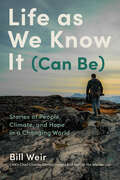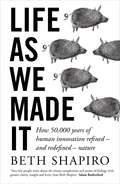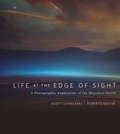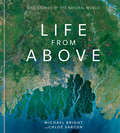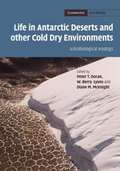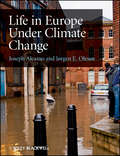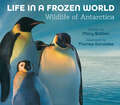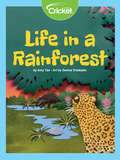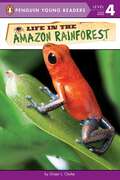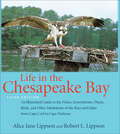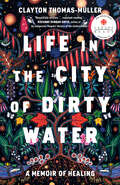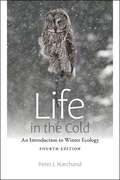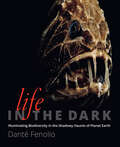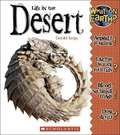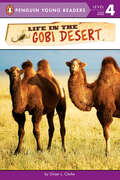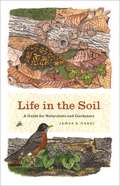- Table View
- List View
Life and Times of Horatio Hornblower: A Biography of C.S. Forester's Famous Naval Hero
by C. Northcote ParkinsonMany know of Horatio Hornblower's exploits during the Napoleonic Wars through the novels of C.S. Forester, but how many know the true Hornblower – the man who rose from midshipman to admiral of the British Fleet? Using Hornblower family papers discovered in the 1970s, C. Northcote Parkinson has set the record straight in this authoritative biography. Drawn from the Hornblower series as well as from Parkinson's knowledge of the Royal Navy, this account of the popular fictional hero is as entertaining as the C.S. Forester novels themselves.
Life as We Know It (Can Be): Stories of People, Climate, and Hope in a Changing World
by Bill WeirAward-winning journalist and CNN chief climate correspondent Bill Weir draws on his years of immersive travel and reporting to share the best ideas and stories of hope and positivity from the people and communities around the world who are thriving in the wake of climate change, and what we can learn from them to build a more promising future.While reporting from every state and every continent, and filming his acclaimed CNN Original Series The Wonder List, Bill Weir has spent decades telling the stories of unique people, places, cultures, and creatures on the brink of change. As the first Chief Climate Correspondent in network news, he’s immersed in the latest science and breakthroughs on the topic, while often on the frontlines of disasters, natural and manmade.In 2020, Bill began distilling these experiences into a series of Earth Day letters for his then-newborn son to read in 2050, to help him better understand the world he will have grown up in and be better prepared to embrace the future. Bill’s work and his letters were the inspiration for Life As We Know It (Can Be), which confronts the worry and wonder of climate change with messages and examples of hope for all of us on how a better future can still be written.Highlighting groundbreaking innovation in fields of clean energy, food and water sources, housing and building materials, and more, and touching on how happiness, resilience, and health and wellness factor into the topic of climate change, Bill’s stories take readers on a global journey, from one community in Florida that took on a hurricane and never lost power, to the Antarctic Peninsula where one species of penguin is showing us the key to survival, to the nuclear fusion labs where scientists are trying to build a star in a box. In these pages, we join a search for ancient wisdom and new ideas.Life As We Know It (Can Be) is a celebration of the wonders of our planet, a meditation on the human wants and needs that drive it out of balance, and an inspiration for communities to galvanize around nature and each other as the very best way to best prepare and plan for what’s next.
Life as We Made It: How 50,000 Years of Human Innovation Refined—and Redefined—Nature
by Beth ShapiroFrom the first dog to the first beefalo, from farming to CRISPR, the human history of remaking nature When the 2020 Nobel Prize was awarded to the inventors of CRISPR, the revolutionary gene-editing tool, it underlined our amazing and apparently novel powers to alter nature. But as biologist Beth Shapiro argues in Life as We Made It, this phenomenon isn&’t new. Humans have been reshaping the world around us for ages, from early dogs to modern bacteria modified to pump out insulin. Indeed, she claims, reshaping nature—resetting the course of evolution, ours and others&’—is the essence of what our species does. In exploring our evolutionary and cultural history, Shapiro finds a course for the future. If we have always been changing nature to help us survive and thrive, then we need to avoid naive arguments about how we might destroy it with our meddling, and instead ask how we can meddle better. Brilliant and insightful, Life as We Made It is an essential book for the decades to come.
Life as We Made It: How 50,000 years of human innovation refined – and redefined – nature
by Beth ShapiroFrom the very first dog to glowing fish and designer pigs – the human history of remaking nature. Virus-free mosquitoes, resurrected dinosaurs, designer humans – such is the power of the science of tomorrow. But this idea that we have only recently begun to manipulate the natural world is false. We&’ve been meddling with nature since the last ice age. It&’s just that we&’re getting better at it – a lot better. Drawing on decades of research, Beth Shapiro reveals the surprisingly long history of human intervention in evolution through hunting, domesticating, polluting, hybridizing, conserving and genetically modifying life on Earth. Looking ahead to the future, she casts aside the scaremongering myths on the dangers of interference, and outlines the true risks and incredible opportunities that new biotechnologies will offer us in the years ahead. Not only do they present us with the chance to improve our own lives, but they increase the likelihood that we will continue to live in a rich and biologically diverse world.
Life as a Hunt: Thresholds of Identities and Illusions on an African Landscape
by Stuart MarksThe "extensive wilderness" of Zambia's central Luangwa Valley is the homeland of the Valley Bisa whose cultural practices have enriched this environment for centuries. Beginning with the intrusions of warlords and later British colonials, successive generations have experienced the callousness and challenges of colonialism. Their homeland, a slender corridor surrounded by three national parks and an escarpment, is a microcosm of the political, economic and cultural battlefields surrounding most African protected areas today. The story of the Valley Bisa diverges from the myths that conservationists, administrators, and philanthropists, tell about Africa's environmental and wildlife crises.
Life at the Edge of Sight: A Photographic Exploration of the Microbial World
by Scott Chimileski Roberto Kolter Moselio SchaechterThis stunning photographic essay opens a new frontier for readers to explore through words and images. Microbial studies have clarified life’s origins on Earth, explained the functioning of ecosystems, and improved both crop yields and human health. Scott Chimileski and Roberto Kolter are expert guides to an invisible world waiting in plain sight.
Life at the Extremes: The Science of Survival
by Frances AshcroftThe challenge of scaling the highest mountain, exploring the deepest ocean, crossing the hottest desert, or swimming in near-freezing water is irresistible to many people. Life at the Extremes is an engrossing exploration of what happens to our bodies in these seemingly uninhabitable environments. Frances Ashcroft weaves stories of extraordinary feats of endurance with historical material and the latest scientific findings as she investigates the limits of human survival and the remarkable adaptations that enable us to withstand extreme conditions. What causes mountain sickness? How is it possible to reach the top of Everest without supplementary oxygen, when passengers in an airplane that depressurized at the same altitude would lose consciousness in seconds? Why do divers get the bends but sperm whales do not? How long you can survive immersion in freezing water? Why don't penguins get frostbite? Will men always be faster runners than women? How far into deep space can a body travel?
Life from Above: Epic Stories of the Natural World
by Michael Bright Chloe SaroshWith over 200 spectacular images, including astonishing satellite photographs and stills from the PBS docuseries, Life from Above reveals our planet as you've never seen it before.Thanks to advanced satellite images, we can now see the earth's surface, its megastructures, weather patterns, and natural wonders in breathtaking detail. From the colors and patterns that make up our planet to the mass migrations and seismic changes that shape it, Life from Above sheds new light on the place we call home. It reveals the intimate stories behind the images, following herds of elephants crossing the plains of Africa and turtles traveling on ocean currents that are invisible unless seen from space. The true colors of our planet are revealed, from the striped tulip fields of Holland to the vivid turquoise lakes in Iceland to the green swirl of a plankton super bloom attracting a marine feeding frenzy. Whether it's the world's largest beaver dam--so remote it was discovered only through satellite imagery--or newly formed islands born from volcanic eruptions, you'll discover new perspectives with every image.
Life in Antarctic Deserts and Other Cold Dry Environments
by Peter T. Doran W. Berry Lyons Diane M. Mcknight"The McMurdo Dry Valleys form the largest relatively ice-free area on the Antarctic continent. The perennially ice-covered lakes, ephemeral streams and extensive areas of exposed soil are subject to low temperatures, limited precipitation and salt accumulation. The dry valleys thus represent a region where life approaches its environmental limits. This unique ecosystem has been studied for several decades as an analog to environments on other planets, particularly Mars. For the first time, the detailed terrestrial research of the dry valleys is brought together here, presented from an astrobiological perspective. Chapters include a discussion on the history of research in the valleys, a geological background of the valleys, setting them up as analogs for Mars, followed by chapters on the various sub-environments in the valleys such as lakes, glaciers and soils. Includes concluding chapters on biodiversity and other analog environments on Earth"--Provided by publisher.
Life in Europe Under Climate Change
by Joseph Alcamo Jorgen E. OlesenLife in Europe will indeed go on as the climate changes, but not in the same way as before. The air will be warmer, winds will change, patterns of rainfall and snowfall will alter, and sea level is likely to rise. These phenomena are already being seen. Europe will in the future experience marked changes in vegetation cover, increased floods along rivers and coastlines as well as more frequent droughts and forest fires, often leading to large societal costs. The changes will be minor in some cases, profound in others, but in any case, pervasive. This book uses the most up to date information issued by the IPCC (Intergovernmental Panel on Climate Change), and informs readers about these effects, as well as showing how Europe is contributing to attempts to slow the tempo of global climate change, and how it can adapt to the climate change that seems unavoidable. Life in Europe under Climate Change makes essential information on climate impacts in Europe accessible to a broad audience, including students, politicians, planners and members of non-governmental organizations.
Life in Hot Water: Wildlife at the Bottom of the Ocean
by Mary BattenA dramatic overview of the deep-sea extremophiles that thrive in scalding water and permanent darkness at the bottom of the oceanThe scalding-hot water gushing from vents at the bottom of the ocean is one of the most extreme environments on Earth. Yet over millions of years, many organisms—from chemical-eating bacteria to eyeless crabs and iron-shelled snails—have evolved in amazing ways that enable them to thrive in this unlikely habitat. Scientists are hard at work to learn more about the complex ecosystems of the ocean depths.Award-winning science writer Mary Batten and New York Times best-selling illustrator Thomas Gonzalez, the masterful duo that created Life in a Frozen World, team up again in this impressive overview of hydrothermal ocean vents. Her clear, informative text coupled with his unique and eerily realistic paintings of sights never seen on land—gushing "black smokers," ghostly blind shrimp, red-plumed tube worms—will entice readers to learn more about this once-hidden world at the bottom of the sea.
Life in a Frozen World: Wildlife of Antarctica
by Mary BattenAntarctica is one of the most extreme environments on Earth—the coldest, windiest, driest place on the planet. This frozen continent affects weather, ocean currents, and sea levels all over the Earth.From award-winning, experienced nature writer Mary Batten comes a remarkable nonfiction picture book that plumbs the mysteries of this hostile environment. With clear, engaging language, Batten explores fascinating questions that scientists the world over have been researching, such as how a wide variety of wildlife can survive in this frigid environment and how Antarctica might be the key to long-standing questions about the Earth and climate change.New York Times bestselling illustrator Thomas Gonzalez brings Batten's text to life with detailed, realistic paintings. An ideal resource for young science lovers and educators, this informative volume is perfect for classroom units on climate change, conservation, ecology, oceanography, and more.
Life in a Rainforest
by Amy TaoDo you know how many animals live in the Amazonian rainforest? Learn about the different predators and prey that coexist and depend on one another to survive in their ecosystem.
Life in the Amazon Rainforest (Penguin Young Readers, Level 4)
by Ginjer L. ClarkeJourney through the jungle in this fact-packed leveled reader!Welcome to the largest rainforest in the world, a vast wonder just waiting for you to explore. Follow along as pink dolphins dart through the flooded river, vampire bats swoop down from the trees, and giant green anacondas slowly slither across the forest floor. This humongous habitat is home to millions of plants, animals, and people. But large as it may be, the Amazon Rainforest is in danger--and shrinking fast. Learn more about this amazing place and discover what you can do to help save the rainforest!
Life in the Chesapeake Bay
by Alice Jane Lippson Robert L. LippsonLife in the Chesapeake Bay is the most important book ever published on America's largest estuary. Since publication of the first edition in 1984, tens of thousands of naturalists, boaters, fishermen, and conservationists have relied on the book's descriptions of the Bay's plants, animals, and diverse habitats. Superbly illustrated and clearly written, this acclaimed guide describes hundreds of plants and animals and their habitats, from diamondback terrapins to blue crabs to hornshell snails.Now in its third edition, the book has been updated with a new gallery of thirty-nine color photographs and dozens of new species descriptions and illustrations. The new edition retains the charm of an engaging classic while adding a decade of new research.This classic guide to the plants and animals of the Chesapeake Bay will appeal to a variety of readers—year-round residents and summer vacationers, professional biologists and amateur scientists, conservationists and sportsmen.
Life in the Chesapeake Bay: An Illustrated Guide to the Fishes, Invertebrates, Plants, Birds, and Other Inhabitants of the Bays and Inlets from Cape Cod to Cape Hatteras
by Alice Jane Lippson Robert L. Lippson“The best-written and best-illustrated guide ever about a North American tidal estuary. It is the model for all future coastal nature guides.” —Whole Earth Review Life in the Chesapeake Bay is the most important book ever published on America’s largest estuary. Since publication of the first edition in 1984, tens of thousands of naturalists, boaters, fishermen, and conservationists have relied on the book’s descriptions of the Bay’s plants, animals, and diverse habitats. Superbly illustrated and clearly written, this acclaimed guide describes hundreds of plants and animals and their habitats, from diamondback terrapins to blue crabs to hornshell snails.Now in its third edition, the book has been updated with a new gallery of thirty-nine color photographs and dozens of new species descriptions and illustrations. The new edition retains the charm of an engaging classic while adding a decade of new research.This classic guide to the plants and animals of the Chesapeake Bay will appeal to a variety of readers—year-round residents and summer vacationers, professional biologists and amateur scientists, conservationists and sportsmen.“Handsome, generously illustrated . . . All of the Bay’s richness is catalogued here.” —The Washington Post Book World“A story book, a field guide and a reference work, and anyone interested in fishing, ecology, or our bay should own it.” —The Baltimore Sun“The region’s quintessential field and reference guide.” —Chesapeake Life Magazine“One of the most popular, well written, and useful guides to the Chesapeake.” —Northeastern Naturalist
Life in the City of Dirty Water: A Memoir of Healing
by Clayton Thomas-MullerAn electrifying memoir that braids together the urgent issues of Indigenous rights and environmental policy, from a nationally and internationally recognized activist and survivor.There have been many Clayton Thomas-Mullers: The child who played with toy planes as an escape from domestic and sexual abuse, enduring the intergenerational trauma of Canada's residential school system; the angry youngster who defended himself with fists and sharp wit against racism and violence, at school and on the streets of Winnipeg and small-town British Columbia; the tough teenager who, at 17, managed a drug house run by members of his family, and slipped in and out of juvie, operating in a world of violence and pain.But behind them all, there was another Clayton: the one who remained immersed in Cree spirituality, and who embraced the rituals and ways of thinking vital to his heritage; the one who reconnected with the land during summer visits to his great-grandparents' trapline in his home territory of Pukatawagan in northern Manitoba.And it's this version of Clayton that ultimately triumphed, finding healing by directly facing the trauma that he shares with Indigenous peoples around the world. Now a leading organizer and activist on the frontlines of environmental resistance, Clayton brings his warrior spirit to the fight against the ongoing assault on Indigenous peoples' lands by Big Oil.Tying together personal stories of survival that bring the realities of the First Nations of this land into sharp focus, and lessons learned from a career as a frontline activist committed to addressing environmental injustice at a global scale, Thomas-Muller offers a narrative and vision of healing and responsibility.
Life in the Cold: An Introduction to Winter Ecology, Fourth Edition
by Peter J. MarchandPeter J. Marchand’s Life in the Cold remains the one book that offers a comprehensive picture of the interactions of plants and animals—including humans—with their cold-weather environment. Focusing on the problems of “winter-active” organisms, Marchand illuminates the many challenges of sustaining life in places that demand extraordinary adaptations. The fourth edition of this classic text includes a new chapter on climate change and its effects on plants and animals wintering in the North.
Life in the Dark: Illuminating Biodiversity in the Shadowy Haunts of Planet Earth
by Danté FenolioStunning, never-before-seen photographs of creatures that live in complete darkness.Honorable Mention for Technical Text of the Washington PublishersDeep inside caves, at the bottoms of oceans and lakes, beneath the ground: these concealed habitats are absent of sunlight. This strange and fascinating world of complete darkness is not a solitary place—it is inhabited by millions of life forms. Yet most humans—creatures of daylight—have never seen any of them. Until now. In this fascinating—sometimes eerie—book, extreme wildlife photographer and scientist Danté Fenolio brings the denizens of these shadowy haunts into focus. Life in the Dark shows us the many ways in which life forms have adapted to lightless environments, including refinements of senses, evolution of unique body parts, and illumination using "biological flashlights." With more than 200 mesmerizing color photographs, Life in the Dark unveils bizarre creatures like the firefly squid, the giant Amazonian catfish, the Chinese cavefish, and even the human bot fly, which lives in the darkness beneath its host’s skin. Fenolio’s rich and vibrant images shed new light on the world’s fascinating creatures of darkness.
Life in the Desert (What on Earth?)
by Gerald LeggEarth is a wonderous planet--and What on Earth? will explore each and every facet of the planet in a way that will delight 2nd to 4th graders, librarians and parents alike! No other series for this age takes such an in depth look at each subject covered.
Life in the Gobi Desert (Penguin Young Readers, Level 4)
by Ginjer L. ClarkeDiscover the desert in this fact-packed leveled reader!Welcome to the Gobi Desert, where you can find camels, scorpions, and even snow leopards! Explore this huge habitat and meet the many creatures that call it home. But keep an eye out for the ones that are no longer alive, too--the Gobi may have more dinosaur fossils than any other place on Earth! Learn more about this amazing place as well as how you can help protect and preserve it for future generations.
Life in the Himalaya: An Ecosystem at Risk
by Maharaj K. PanditThe collision of the Indian and Eurasian plates 50 million years ago created the Himalaya, along with massive glaciers, intensified monsoon, turbulent rivers, and an efflorescence of ecosystems. Today, the Himalaya is at risk of catastrophic loss of life. Maharaj Pandit outlines the mountain’s past in order to map a way toward a sustainable future.
Life in the Rain Forest
by Christine A. CaputoLearn more about rain forests, and the unique plants and animals that live in them.
Life in the Redwood Forest (Fountas & Pinnell Classroom, Guided Reading Grade 3)
by Joanna SolinsNIMAC-sourced textbook
Life in the Soil: A Guide for Naturalists and Gardeners
by James B. NardiLeonardo da Vinci once mused that "we know more about the movement of celestial bodies than about the soil underfoot," an observation that is as apt today as it was five hundred years ago. The biological world under our toes is often unexplored and unappreciated, yet it teems with life. In one square meter of earth, there lives trillions of bacteria, millions of nematodes, hundreds of thousands of mites, thousands of insects and worms, and hundreds of snails and slugs. But because of their location and size, many of these creatures are as unfamiliar and bizarre to us as anything found at the bottom of the ocean. Life in the Soil invites naturalists and gardeners alike to dig in and discover the diverse community of creatures living in the dirt below us. Biologist and acclaimed natural history artist James B. Nardi begins with an introduction to soil ecosystems, revealing the unseen labors of underground organisms maintaining the rich fertility of the earth as they recycle nutrients between the living and mineral worlds. He then introduces readers to a dazzling array of creatures: wolf spiders with glowing red eyes, snails with 120 rows of teeth, and 10,000-year-old fungi, among others. Organized by taxon, Life in the Soil covers everything from slime molds and roundworms to woodlice and dung beetles, as well as vertebrates from salamanders to shrews. The book ultimately explores the crucial role of soil ecosystems in conserving the worlds above and below ground. A unique and illustrative introduction to the many unheralded creatures that inhabit our soils and shape our environment above ground, Life in the Soil will inform and enrich the naturalist in all of us.

